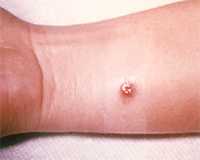Symptoms
The symptoms of anthrax depend on the type of infection and can take anywhere from 1 day to more than 2 months to appear. All types of anthrax have the potential, if untreated, to spread throughout the body and cause severe illness and even death.
Cutaneous anthrax symptoms can include:

- A group of small blisters or bumps that may itch
- Swelling can occur around the sore
- A painless skin sore (ulcer) with a black center that appears after the small blisters or bumps
- Most often the sore will be on the face, neck, arms, or hands
Inhalation anthrax symptoms can include:
- Fever and chills
- Chest Discomfort
- Shortness of breath
- Confusion or dizziness
- Cough
- Nausea, vomiting, or stomach pains
- Headache
- Sweats (often drenching)
- Extreme tiredness
- Body aches
Gastrointestinal anthrax symptoms can include:
- Fever and chills
- Swelling of neck or neck glands
- Sore throat
- Painful swallowing
- Hoarseness
- Nausea and vomiting, especially bloody vomiting
- Diarrhea or bloody diarrhea
- Headache
- Flushing (red face) and red eyes
- Stomach pain
- Fainting
- Swelling of abdomen (stomach)
Injection anthrax symptoms can include:
- Fever and chills
- A group of small blisters or bumps that may itch, appearing where the drug was injected
- A painless skin sore with a black center that appears after the blisters or bumps
- Swelling around the sore
- Abscesses deep under the skin or in the muscle where the drug was injected
To Keep in Mind
Injection anthrax symptoms are similar to those of cutaneous anthrax, but injection anthrax can spread throughout the body faster and be harder to recognize and treat than cutaneous anthrax. Skin and injection site infections associated with injection drug use are common and do not necessarily mean the person has anthrax.
CDC guidance and case definitions are available to help doctors diagnose anthrax
- Page last reviewed: July 23, 2014
- Page last updated: July 23, 2014
- Content source:


 ShareCompartir
ShareCompartir